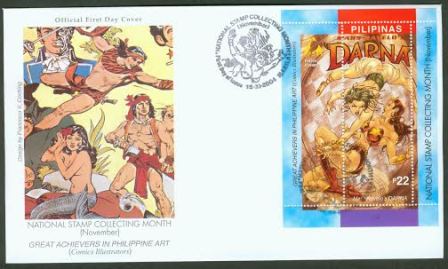2004, November 15. National Stamp Collecting Month
Featuring Comics Illustrators and Their Works
Litho Offset. Amstar Company, Inc. Perf. 14.
Singles, Souvenir Sheets of One
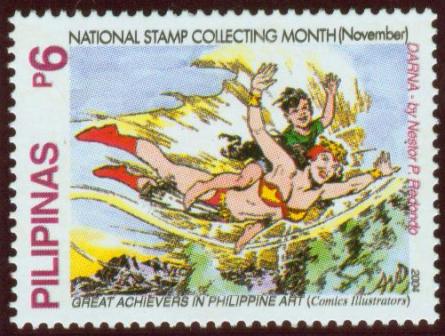
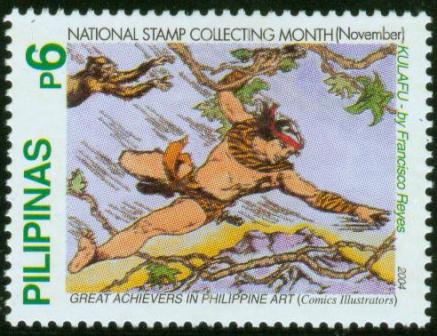


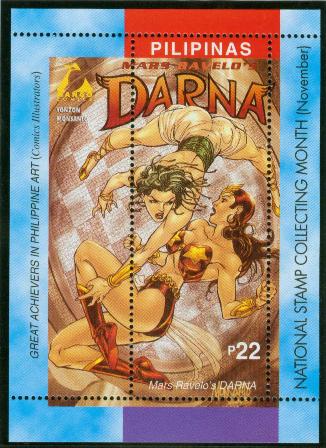
6p Darna by Nestor P. Redondo - Singles (35,000)
6p Kulafu by Francisco Reyes - Singles (35,000)
6p Lapu-lapu by Francisco V. Coching - Singles (35,000)
6p El Vibora by Federico C. Javinal - Singles (35,000)
Souvenir Sheets of One (10,000)
22p Darna by Mars Ravelo
Layout Artists: Alfonso V. Divina, Victorino Z. Serevo
Design Coordinator: Ramon Orlina
Designs: Stamp Illustrations from the book "A History of the Komiks of the Philippines and Other Countries" provided by Abe Ocampo. Souvenir Sheet design from Mars Ravelo's Darna furnished by Mosanto of Yonzon's Mango Comics.
First Day Covers: Manila
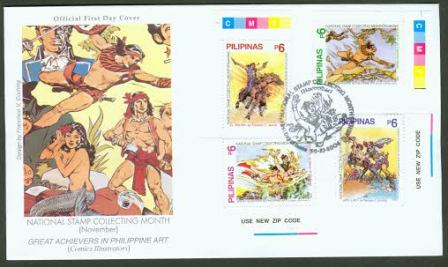
National Stamp Collecting Month - Featuring Comic Illustrators
Darna, by Nestor Redondo and Mars Ravelo. Nestor Redondo was exposed to komiks before he could read and write. His father used to bring him imported comics. What fascinated him were Tarzan, Buck Rogers, Superman, Flash Gordon, The Lone Ranger and Captain America. He took up Architecture at the Mapua Institute of Technology, and at the same time illustrating komiks stories for the Bulaklak Publications. Soon, he was neck deep in the komiks craft. He illustrated a serial, Palos, penned by his brother Virgilio, who is himself an illustrator. Palos was successful and ran for 14 years. Then followed other stories by Virgilio, among them Diwani and Gagamba. Also did the artwork for most of Pablo Gomez's opuses; Gflda, Bangkusay and Dayukdok Redondo's popularity really skyrocketed when he was commissioned by the Ace Publications to illustrate Mars Ravelo's blockbuster series Darna. In 1972, he established contact with American comic book and magazine publishers. That started his international exposure. Initially, he illustrated several episodes of Burrough's Tarzan. Later, he took over the artwork for The Swamp Thing, a very popular series in the United States. He ran an art studio in his Valenzuela, Bulacan home, and accepted commissions from U.S. publishing firms. He participated in art exhibits here and in the U.S., and lectured abroad on komiks illustration. In 1979, he was bestowed the prestigious 'Inkpot Award' by the San Diego (California) Comics Convention. Previous to this, he was the recipient of the Valenzuela (Bulacan) Kalikasan Award for his outstanding contributions to the advancement of arts and culture as a comicís illustrator.
Kulafu, by Francisco Reyes. Francisco Reyes is recognized as the King of the Philippine-jungle lord school of komiks-strip writing. He created Kulafu, which was a success in the Liwayway Magazine during the 1930s. Reyes studied art in 1927 at the UP School of Fine Arts. Upon graduation in 1932, he joined the Liwayway Publications. He teamed up on Kulafu with Pedrito Reyes. Kulafu was the first colored adventure strip in Philippine komiks-magazine history. Kulafu's creator owes a lot to Edgar Rice Burroughs, who created Tarzan. Tarzan lived as a savage of noble English lineage in Victorian Africa; Kulafu's domain was a little kingdom somewhere in the southern Philippines during the pre-Spanish era. Reared by the great apes like Tarzan, Kulafu roamed the jungles coming out alive from one perilous adventure after another. Reyes worked on Kulafu solo in 1936 when Pedrito Reyes decided to tackle another job. In 1941, he stopped doing Kulafu altogether. Later, he created other strips that also clicked: Talahib (1946), Kilabot (1947), Buhawi (1947) and Mahiwagang Sinulid (1949). He also illustrated Joe Safari (1947), Dagog (1967), Sphinx (1969) and Ogganda (1964), all of which were written by Clodualdo del Mundo.
Lapu-lapu, by Francisco V. Coching. Coching was born on January 29, 1919. He left school at an early age to work for the magazine Liwayway, where his father was a novelist. He apprenticed with Tony Velasquez. In 1934, he created Bing Bigotilyo, and the year after, Marabini. After the war, he created Bulalakaw However, it was Hagibis, his next work, that won him fame. Hagibis, which was inspired by Kulafu of Francisco Reyes and Tarzan of Edgar Rice Burroughs, ran for 15 years in Liwayway and was followed by sequels: Anak ni Hagibis and Si Gat Sibasib. Coching's creations were sought out by producers who made movies out of them. All but three of his dozens of komiks novels were made into movies. Coching both wrote and illustrated his stories. His works had strong narrative flow, brimming with drama, and punctuated by actions and surprise. His illustrative style belonged to the romantic tradition of komiks illustration, which he dominated from 1934 until 1973, the year he retired.
El Vibora, by Federico C. Javinal. The first time Federico Javinal applied for work as an illustrator, his work was rejected by Tony Velasquez, then editor of Ace Publications. He then gave his style more polish and went to Bulaklak komiks, where he was accepted in 1955. In 1956, his long- time idol- Francisco Coching - asked him to be his assistant for the artwork of his stories for various komiks and magazines. Javinal was Coching's artistic partner from then on. Their collaboration ended after 17 years, with the latter's retirement. Together, they came out with Salabusab, Pedro Penduko, El Vibora and Dimasalang, among others. Later, he illustrated Amado Yasanas novels in Liwayway magazine. Among them were Anak ng Tulisan, Tom Cat, Kamaong Asero, Antigo and Kahadang Bato. He later transferred to the Graphic Arts Service, Inc., where he illustrated Alakdang Bato, a novel which was later made into a movie. Tony Velasquez, who turned him away at the start of his career, finally got him to illustrate his Mga kwento ni Kenkoy
-
Philately
-
Famous Filipinos
-
Art
